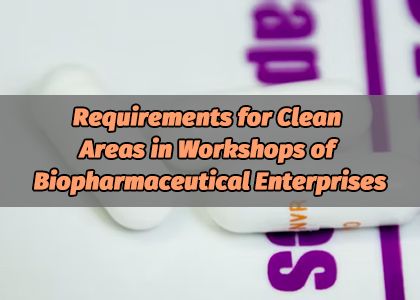
As a pharmaceutical enterprise, the whole production process must meet the GMP standards in order to ensure product quality, and the GMP purification workshop technology of biopharmaceutical enterprises is one of the main means to ensure the successful implementation of GMP.
According to the number of bacteria and dust particles in the environment as the main control objects, while the environmental temperature and humidity, pressure difference, illumination, noise and other relevant provisions are made, the biopharmaceutical workshop clean zoning is divided into A, B, C, D four levels. Specific requirements are as follows:
1. GMP workshop clean area cleanliness grade standard
|
Dynamic level criteria for bacterial detection in decontamination areas (to be monitored with a plankton sampler) |
||||
|
Cleanliness classification |
floating bacteria |
settling microbe |
Surface microorganism |
|
|
contact |
Five-finger glove |
|||
|
cfu/m³ |
cfu/4h |
cfu/plate |
cfu/ glove |
|
|
Class A |
<1 |
<1 |
<1 |
<1 |
|
Class B |
10 |
5 |
5 |
5 |
|
Class C |
100 |
50 |
25 |
/ |
|
Class D |
200 |
100 |
50 |
/ |
2. GMP workshop clean area working environment requirements
|
The New Version of GMP Cleanliness A, B, C, D Main Parameter Requirements |
|
|
Class A |
The air temperature in the clean operating area should be 20~24° C |
|
The relative humidity of the air in the clean operation area should be 45%-60% |
|
|
Wind speed in the operating area: horizontal wind speed ≥0.54m/s: vertical wind speed ≥0.36m/s |
|
|
The leak detection of HEPA filter is greater than 99.97% |
|
|
Illumination: >300x-600x |
|
|
Noise: ≤75db(dynamic test) |
|
|
Class B |
The air temperature in the clean operating area should be 20~24° C |
|
The relative humidity of the air in the clean operation area should be 45%-60% |
|
|
Room air change times: 50-60 times /h |
|
|
Pressure difference: Class B area is relative to outdoor ≥10P, and different areas of the same level should be kept special according to the air flow direction |
|
|
The leak detection of HEPA filter is greater than 99.97% |
|
|
Illumination: >300lx-600lx |
|
|
Noise: ≤75db (dynamic test) |
|
|
Class C |
The air temperature in the clean operating area should be 20~24° C |
|
The relative humidity of the air in the clean operation area should be 45%-60% |
|
|
Room air change times: ≥25 times /h |
|
|
Pressure difference: Class C area is relative to outdoor ≥10P, and different areas of the same level should be kept special according to the air flow direction |
|
|
The leak detection of HEPA filter is greater than 99.97% |
|
|
Illumination: >300lx-600lx |
|
|
Noise: ≤75db (dynamic test) |
|
|
Class D |
The air temperature in the clean operating area should be 18~26° C |
|
The relative humidity of the air in the clean operation area should be 45%-60% |
|
|
Room air change times: ≥15 times /h |
|
|
Pressure difference: Class 100000 area is relative to outdoor ≥10P, and different areas of the same level should be kept special according to the air flow direction |
|
|
The leak detection of HEPA filter is greater than 99.97% |
|
|
Illumination: >300lx-600lx |
|
|
Noise: ≤75db (dynamic test) |
|
Instructions:
Class A area: high-risk operating areas, such as filling areas, areas where plastic plug barrels, open ampoules, open westphalling bottles are placed and areas where sterile assembly lines or connection operations are performed. Laminar flow operating table (hood) is usually used to maintain the environmental state of the area. The laminar flow system must supply air uniformly in its working area, and the wind speed is 0.3-0.54M/S, (guideline value). There should be data to prove the state of the laminar flow and need verification. Unidirectional flow or lower wind speed may be used in a closed isolated operating area or glove box.
Class B area: refers to the background area of Class A area for high-risk operations such as aseptic preparation and filling.
Class C area and Class D area: refers to the less important degree of clean operation area in the production of sterile drugs.
Class A, B is equivalent to class 100, A level of the background environment is higher, more stringent requirements.
Class C is equivalent to class 10,000, Class D is equivalent to class 100,000
3. GMP workshop clean level and scope of use
|
GMP workshop clean level and scope of use |
||
|
Workshop cleanliness level |
Maximum allowable allowable number of microorganisms (unit: /m³) |
Applicable occasion |
|
Class 300000 |
5000 |
Pill, pellet packaging workshop |
|
Class 100000 |
1000 |
Injection concentration workshop |
|
Class 10000 |
100 |
Small capacity injection filling workshop, direct contact with the medicine package |
|
Class 100 |
5 |
Large capacity injection filling workshop |